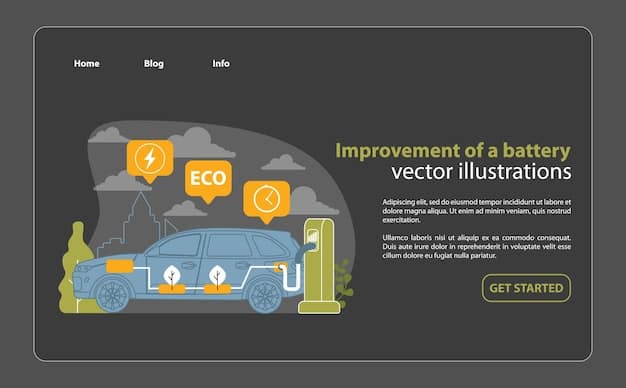Electric Vehicle Battery Recycling: New Rules for Owners in 2025

Electric vehicle battery recycling is set to undergo significant changes in 2025 due to new federal regulations, impacting how EV owners manage and dispose of their batteries, potentially leading to increased recycling rates and reduced environmental impact.
The landscape of electric vehicle battery recycling is poised to transform significantly in 2025. New federal regulations are set to reshape how EV owners handle their end-of-life batteries, promising a more sustainable and environmentally conscious approach.
Understanding the Current State of EV Battery Recycling
Before delving into the specifics of the upcoming regulations, it’s crucial to understand the current state of EV battery recycling. While the EV market is booming, the infrastructure for recycling these batteries is still in its nascent stages.
Currently, several methods are employed for EV battery recycling, each with its own set of advantages and disadvantages. Understanding these methods provides a clearer picture of the improvements the new regulations aim to bring.
Common Recycling Methods
There are two primary methods for recycling EV batteries: pyrometallurgy and hydrometallurgy. Here’s a brief overview of each:
- Pyrometallurgy: This involves high-temperature smelting to recover valuable metals like nickel and cobalt. While effective, it’s energy-intensive and can result in significant emissions.
- Hydrometallurgy: This method uses chemical leaching to dissolve and separate battery components. It’s more environmentally friendly than pyrometallurgy but can be more complex and costly.
- Direct Recycling: A newer approach that aims to recover battery materials without breaking down the chemical compounds. This process is more energy efficient and reduces waste.
Despite these methods, the recycling rate for EV batteries remains relatively low. A significant portion of used batteries ends up in landfills, posing environmental risks due to the potential for heavy metals and other hazardous materials to leach into the soil and water.

The need for improved recycling practices is evident, and the new federal regulations are designed to address these shortcomings and promote a more sustainable lifecycle for EV batteries.
Key Provisions of the New Federal Regulations
The new federal regulations slated for 2025 introduce several key provisions aimed at enhancing the recycling of EV batteries. These regulations are designed to create a more standardized and responsible approach to battery disposal and recycling across the United States.
These provisions target various aspects of the battery lifecycle, from manufacturing to end-of-life management, ensuring that all stakeholders are held accountable for their role in promoting sustainable practices.
Extended Producer Responsibility
One of the most significant aspects of the new regulations is the implementation of Extended Producer Responsibility (EPR). This shifts the responsibility for managing the end-of-life of EV batteries from consumers and local governments to the battery manufacturers themselves.
Under EPR, manufacturers are required to:
- Establish and fund recycling programs for their batteries.
- Meet specific recycling targets to ensure a certain percentage of batteries are recycled.
- Provide clear information to consumers on how to properly dispose of or recycle their EV batteries.
This approach incentivizes manufacturers to design batteries that are easier to recycle and to invest in recycling infrastructure. By holding producers accountable, the regulations aim to increase recycling rates and reduce the environmental impact of EV batteries.
Impact on Electric Vehicle Owners
For electric vehicle owners in the US, the new regulations will bring several notable changes. These changes are designed to make battery recycling more accessible and convenient, while also ensuring that owners are informed about their responsibilities.
Understanding how these regulations will directly affect EV owners is essential for adapting to the new landscape and contributing to a more sustainable future.
Simplified Recycling Processes
One of the most significant benefits for EV owners will be the simplification of the recycling process. Manufacturers will be required to establish convenient collection points and provide clear instructions on how to return used batteries.
This could include:
- Designated drop-off locations at dealerships or recycling centers.
- Mail-back programs for smaller batteries.
- Partnerships with local recycling facilities to accept EV batteries.
By making it easier to recycle batteries, the regulations aim to increase participation rates and ensure that more batteries are properly managed at the end of their life.
Financial Incentives and Potential Cost Savings
The new regulations also open the door for potential financial incentives and cost savings for EV owners. These incentives are designed to encourage responsible battery management and offset any costs associated with recycling.
Exploring these financial aspects can provide additional motivation for EV owners to participate in recycling programs and support sustainable practices.
Tax Credits and Rebates
Some states and local governments may offer tax credits or rebates for EV owners who properly recycle their batteries. These incentives can help offset the cost of purchasing a new battery or provide a financial reward for responsible disposal.
Here are some potential incentives:
- State tax credits for recycling EV batteries.
- Rebates for purchasing new EVs when old batteries are recycled.
- Discounts on battery replacements for participating in recycling programs.
These financial incentives can make recycling more appealing to EV owners and further promote the adoption of sustainable practices.

Challenges and Potential Roadblocks
While the new federal regulations hold great promise, there are potential challenges and roadblocks that need to be addressed to ensure their successful implementation. Overcoming these hurdles is crucial for achieving the desired outcomes and maximizing the benefits of the regulations.
Identifying and addressing these challenges proactively can help pave the way for a smoother transition and a more effective recycling system.
Infrastructure Limitations
One of the primary challenges is the current lack of adequate recycling infrastructure. The existing facilities may not be equipped to handle the increasing volume of EV batteries that will need to be recycled in the coming years.
To address this, it will be necessary to:
- Invest in new recycling facilities and upgrade existing ones.
- Develop more efficient and cost-effective recycling technologies.
- Establish a robust logistics network for collecting and transporting used batteries.
Overcoming these infrastructure limitations is essential for ensuring that the regulations can be effectively implemented and that EV batteries are recycled in a timely and environmentally responsible manner.
Future Outlook and Technological Advancements
The future of EV battery recycling is closely tied to technological advancements and ongoing research and development efforts. Innovations in recycling technologies and battery design will play a crucial role in shaping the industry and ensuring its long-term sustainability.
Staying informed about these developments can provide valuable insights into the potential future of EV battery recycling and its impact on the environment.
Emerging Recycling Technologies
Several emerging recycling technologies hold promise for improving the efficiency and sustainability of EV battery recycling. These technologies aim to recover more valuable materials, reduce energy consumption, and minimize environmental impact.
Some of the most promising technologies include:
- Advanced hydrometallurgical processes that use more environmentally friendly solvents.
- Direct recycling methods that preserve the chemical compounds of battery materials.
- Automated disassembly systems that increase the speed and efficiency of battery processing.
These technological advancements have the potential to revolutionize the EV battery recycling industry and make it more economically viable and environmentally sustainable.
| Key Point | Brief Description |
|---|---|
| ♻️ EPR Implementation | Manufacturers become responsible for battery recycling. |
| 💰 Financial Incentives | Tax credits and rebates for recycling EV batteries. |
| 🚧 Infrastructure Challenges | Addressing limitations in recycling facilities and logistics. |
| 🧪 Tech Advancements | Emerging technologies for efficient and sustainable recycling. |
Frequently Asked Questions
▼
EPR shifts the responsibility for managing the end-of-life of products, like EV batteries, from consumers to the producers themselves. This includes establishing and funding recycling programs.
▼
EV owners will benefit from simplified recycling processes with convenient collection points. They may also receive financial incentives like tax credits for recycling batteries.
▼
The main challenges include limited recycling infrastructure, the need for more efficient technologies, and establishing robust logistics for battery collection and transportation.
▼
Emerging technologies include advanced hydrometallurgical processes with eco-friendly solvents, direct recycling methods, and automated disassembly systems for quicker battery processing.
▼
Financial incentives may include state tax credits for recycling EV batteries, rebates for purchasing new EVs when old batteries are recycled, and discounts on battery replacements.
Conclusion
The impending federal regulations in 2025 mark a pivotal moment for electric vehicle battery recycling. By understanding these changes, EV owners can proactively contribute to a more sustainable future, ensuring that the environmental benefits of electric vehicles are fully realized.





